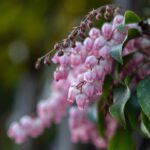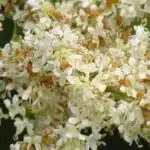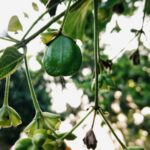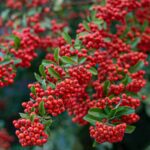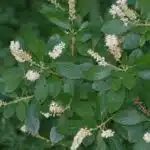The Japanese Plum Yew (Cephalotaxus harringtonia) is a versatile evergreen shrub that can be grown in a range of garden settings. Its attractive foliage and ability to tolerate shade make it an ideal addition to woodland gardens, while its slow growth rate and low-maintenance requirements make it suitable for small urban gardens. In this article, we will explore the benefits of growing the Japanese Plum Yew in the home garden, as well as provide tips on how to care for this unique plant.
The Japanese Plum Yew is native to Japan and China and has been cultivated for centuries for its ornamental value. Its dark green, needle-like leaves give it a distinctive appearance that stands out in any garden setting. The plant is also known for its hardiness and ability to withstand harsh weather conditions, making it an excellent choice for those who live in areas with extreme temperatures or unpredictable weather patterns. By including the Japanese Plum Yew in your garden design, you can create an aesthetically pleasing environment while also benefiting from its practical features.
Overview Of The Japanese Plum Yew
The Japanese Plum Yew, also known as Cephalotaxus harringtonia, is a unique evergreen shrub that is native to Japan. This slow-growing plant can reach up to 10 feet in height and has dark green needles that grow in a spiral pattern around the stem. The leaves of the Japanese Plum Yew are poisonous and should not be consumed by humans or animals.
The Japanese Plum Yew has many uses in landscaping due to its attractive appearance and ability to tolerate shade. It can be used as a specimen plant or as a hedge, providing year-round interest with its dense foliage. Additionally, this plant is deer-resistant, making it an excellent choice for gardens located in areas with high levels of wildlife.
In traditional medicine, various parts of the Japanese Plum Yew have been used for their medicinal properties. The bark and leaves have been used to treat conditions such as asthma and bronchitis, while the seeds have been used to expel worms from the body. However, it is important to note that these medicinal uses have not been scientifically proven and should not be attempted without proper knowledge and guidance from a healthcare professional.
Overall, the Japanese Plum Yew is an intriguing plant that offers both decorative value in landscaping design and potential health benefits through traditional medicine practices. In the following section, we will explore some of the benefits of growing this unique plant in your home garden.
Benefits Of Growing The Japanese Plum Yew
The Japanese Plum Yew (Cephalotaxus harringtonia) is an evergreen shrub that is hardy in USDA zones 5 to 9 and can tolerate temperatures as low as -20°F. The plant is low maintenance, requiring minimal pruning and minimal water once established. The Japanese Plum Yew is drought tolerant and can thrive in a variety of soil types and conditions. These characteristics make it an ideal choice for home gardeners looking for a low maintenance and hardy shrub.
Hardy Nature
The Japanese Plum Yew is a hardy evergreen shrub that can survive harsh winters and drought. Its ability to thrive in difficult conditions makes it a popular choice for home gardeners looking for low-maintenance plants. With its dark green, glossy foliage and unique fruit-like cones, the Japanese Plum Yew is not only functional but also decorative.
Surviving winter is one of the most significant benefits of growing the Japanese Plum Yew. This evergreen shrub can withstand below-freezing temperatures and still maintain its greenery. In fact, it thrives in colder climates and can adapt to various soil types. The plant’s hardiness makes it an excellent option for gardeners who live in areas with extreme weather conditions.
Another advantage of growing the Japanese Plum Yew is its drought tolerance. This shrub can survive dry spells without requiring constant watering or maintenance. Its deep roots enable it to access water from deeper soil layers, allowing it to thrive during periods of drought. As a result, this plant is perfect for homeowners who want an attractive landscaping option without worrying about high water bills or excessive maintenance requirements.
In conclusion, the Japanese Plum Yew’s hardy nature makes it an excellent choice for home gardeners looking for low-maintenance plants that can survive extreme weather conditions and droughts. It offers both functionality and aesthetics, making it a versatile landscaping option that can enhance any outdoor space. Whether you’re a seasoned gardener or new to planting, consider adding the Japanese Plum Yew to your collection for an effortless yet beautiful addition to your garden.
Low Maintenance
Moving forward, another benefit of growing the Japanese Plum Yew is its low maintenance nature. This shrub requires minimal care and attention, making it an ideal plant for busy homeowners who want to spruce up their outdoor space without dedicating too much time to maintenance. With its ability to survive harsh winters and droughts, the Japanese Plum Yew can thrive without constant watering or pruning.
Landscaping ideas with the Japanese Plum Yew are endless. Due to its unique fruit-like cones and dark green foliage, this shrub adds a touch of elegance and interest to any garden or landscape. It can be used as a border plant, hedge, or even as a standalone specimen for added height and texture. The hardy nature of this shrub also makes it perfect for areas that receive little sunlight or have poor soil quality.
Care tips for the Japanese Plum Yew are straightforward. Once established, it requires very little watering and fertilization. Pruning is only necessary to maintain a specific shape or size, making it easy to maintain its natural form if desired. Additionally, adding a layer of mulch around the base of the plant can help retain moisture during dry spells while also protecting the roots from extreme temperatures. Overall, the Japanese Plum Yew’s low-maintenance nature makes it an excellent option for homeowners looking for a beautiful yet easy-to-care-for addition to their outdoor space.
Choosing The Right Location For Your Japanese Plum Yew
As the saying goes, “location is everything,” and this rings true for the Japanese Plum Yew. When choosing a spot for your plant, it’s important to consider the ideal conditions needed for optimal growth. The Japanese Plum Yew thrives in partial shade to full shade and prefers well-draining soil that is slightly acidic. It’s also best to avoid areas with strong winds or extreme temperatures.
While the Japanese Plum Yew is generally easy to care for, there are potential challenges that can arise if it’s not planted in a suitable location. If placed in direct sunlight, the leaves may start to wilt and turn brown. Additionally, if planted in poorly draining soil or an area prone to flooding, root rot can develop and harm the overall health of the plant. By taking these factors into consideration when selecting a location, you can prevent these issues from occurring.
Overall, choosing the right location is crucial for ensuring the success of your Japanese Plum Yew. Once you have found an appropriate spot based on its preferred growing conditions, you can move on to addressing its soil and water requirements.
Soil And Water Requirements
Japanese plum yew is a versatile plant that thrives in different types of soils, but it prefers well-drained soil with a slightly acidic to neutral pH level. The soil should not be too wet or too dry, as the plant may suffer from root rot if left in soggy conditions for extended periods. Improving drainage is crucial to prevent waterlogging, which can be achieved by adding organic matter such as compost or peat moss and mixing it into the soil.
Fertilizing techniques play an essential role in ensuring the growth of healthy Japanese plum yew plants. It is recommended to fertilize the plant at least once a year with a balanced fertilizer before new growth appears in spring. Applying a slow-release fertilizer will provide nutrients continuously over several months, promoting steady and consistent growth. Over-fertilizing can lead to excessive foliage growth and poor fruiting, so it’s important not to overdo it.
Watering requirements for Japanese plum yew are moderate, especially during the growing season when rainfall is scarce. In general, the plant requires deep watering once every week or two during hot and dry weather conditions. However, overwatering should be avoided because it can cause root rot and other diseases. Mulching around the base of the plant will help retain moisture in the soil while also suppressing weed growth.
Next section topic: Planting and Propagation
Planting And Propagation
When deciding to grow the Japanese Plum Yew in your home garden, it is important to consider the planting and propagation techniques. Indoor propagation can be done by taking cuttings from a mature plant and rooting them in a well-draining soil mix. This method should be done during the spring or summer months when the plant is actively growing.
Outdoor planting techniques require selecting an area with partial shade to full sun exposure, and ensuring that the soil is well-draining and rich in organic matter. The Japanese Plum Yew prefers slightly acidic soil with a pH level between 5.0 and 6.5. When planting, ensure that the root ball is covered with soil and that the top of the root ball is level with the ground surface.
By following proper planting and propagation techniques, you will be able to successfully cultivate this unique evergreen shrub in your home garden. In our next section, we will discuss pruning and maintenance techniques that will help keep your Japanese Plum Yew healthy and thriving for years to come.
Pruning And Maintenance
Pruning and Maintenance are essential for the health and longevity of Japanese Plum Yew. Pruning techniques include removing any dead or diseased branches, cutting back any overgrown branches, and shaping the plant to maintain its desired size and shape. It is best to prune during the dormant season in late winter or early spring before new growth begins.
In addition to pruning, a regular maintenance schedule should be established. This includes watering the plant regularly, especially during hot and dry periods, fertilizing with a balanced fertilizer in the spring and fall, and mulching around the base of the plant to retain moisture and suppress weeds. Regularly inspecting the plant for signs of pests or diseases is also recommended.
By following proper pruning techniques and establishing a regular maintenance schedule, you can ensure that your Japanese Plum Yew remains healthy and vibrant for years to come. However, even with proper care, pests and diseases can still become an issue. In order to effectively deal with these problems, it is important to identify them early on and take appropriate action.
Dealing With Pests And Diseases
While pruning and maintenance are important aspects of growing the Japanese Plum Yew, it is also crucial to take preventative measures to ensure that your plant remains healthy and free from pests and diseases. One common issue that may arise when growing this plant is spider mites. These tiny pests often appear in large numbers and can quickly cause damage to the leaves of the plant. To prevent an infestation, it is important to keep the plant well-watered and to regularly clean the leaves with a damp cloth.
Another potential problem that may affect your Japanese Plum Yew is powdery mildew. This fungal disease often appears as a white or gray powdery coating on the leaves and can be caused by a number of factors including poor air circulation, overcrowding, and excess moisture. To prevent powdery mildew from taking hold, it is important to provide good air circulation around the plant and avoid watering too frequently or allowing water to pool around the base of the plant.
If you do encounter pests or diseases on your Japanese Plum Yew, there are several natural remedies that you can try before resorting to chemical pesticides. For example, neem oil is an effective insecticide that can be used to control a wide range of pests including spider mites. Similarly, baking soda mixed with water can help to control powdery mildew by altering the pH of the leaf surface and making it less hospitable to fungi. By taking preventative measures and using natural remedies when necessary, you can help ensure that your Japanese Plum Yew remains healthy and beautiful for years to come.
Moving forward from dealing with pests and diseases on your Japanese Plum Yew, creative garden design ideas can enhance its aesthetic value while providing practical benefits as well.
Creative Garden Design Ideas
Creative Garden Design Ideas:
Vertical gardening is a great way to maximize limited space while still being able to grow plenty of plants. This method involves growing plants vertically using structures such as trellises, walls or fences. The Japanese plum yew can be grown in this manner, and its narrow form makes it an ideal choice for vertical gardening. By training the branches upward, the plant can be made to take up less horizontal space while still providing an attractive display of foliage.
Container planting is another option that allows gardeners to grow plants in small spaces or on patios and balconies. Japanese plum yews are well-suited for container planting because they are slow-growing and do not require frequent repotting. They also have a shallow root system which means they can be grown in relatively small containers. When selecting containers for these plants, it’s important to choose those with good drainage since they do not tolerate wet soil.
Combining different types of plants in a single container can create a visually appealing display. One idea would be to pair Japanese plum yews with other evergreen shrubs or flowering perennials that complement their color and texture. Another creative idea would be to use the plant as a centerpiece surrounded by smaller annuals or herbs that spill over the sides of the container. By experimenting with different combinations, gardeners can create unique and eye-catching displays that enhance any living space.
Transition:
Now that we’ve explored some creative ways to grow Japanese plum yews in small spaces, let’s turn our attention towards harvesting and using this versatile plant in various applications around your home garden.
Harvesting And Using The Japanese Plum Yew
Creative Garden Design Ideas have been explored in the previous section, and now we move on to the practical aspect of growing a Japanese Plum Yew in your garden. This evergreen shrub is native to Japan, and it can be grown in many regions across the United States. The Japanese Plum Yew has a unique appearance that makes it an ideal choice for creative garden designs.
The Japanese Plum Yew is low maintenance and easy to grow, making it an excellent choice for novice gardeners. It prefers partial sun or shade and well-drained soil. The shrub can reach up to 15 feet tall but can be pruned to maintain its desired size. The plant’s leaves are dark green, glossy, and needle-like, which gives it a unique texture that contrasts beautifully with other plants in your garden.
Apart from its ornamental value, the Japanese Plum Yew has culinary uses and medicinal properties. Its leaves contain alkaloids that are used in traditional Chinese medicine to treat ailments such as asthma, rheumatism, and bronchitis. Additionally, the leaves’ extract is used as an ingredient in some skincare products due to its antioxidant properties. The shrub’s fruit is edible when fully ripe and is often used for making jams or wine.
In conclusion: adding the Japanese Plum Yew to your garden will not only add aesthetic value but also provide you with medicinal benefits and culinary uses. This evergreen shrub’s unique appearance will complement other plants in your garden while adding texture and contrast. Whether you are an experienced gardener or just starting out, the Japanese Plum Yew is a low maintenance plant that will thrive with minimal care while providing various benefits for you and your family.
Conclusion: Adding The Japanese Plum Yew To Your Garden
Adding the Japanese Plum Yew to your garden can bring numerous benefits. This evergreen shrub is not only aesthetically pleasing but also adds diversity to your garden. Its dark green foliage and unique texture make it an excellent choice for borders, hedges or as a focal point in any landscape.
One of the benefits of diversity in gardening is that it helps to create a more resilient ecosystem. By adding different plants such as the Japanese Plum Yew, you create habitat for beneficial insects and pollinators, which in turn help to reduce pest populations naturally. This plant has also been known to deter deer from browsing on other plants in your garden.
Companion planting is another great benefit of incorporating the Japanese Plum Yew into your home garden. The shrub’s acidic soil conditions make it a perfect companion for acid-loving plants like azaleas and rhododendrons. Additionally, its shade tolerance makes it an ideal plant for understory planting with other trees or taller shrubs. Overall, the Japanese Plum Yew is a versatile plant that can add value and diversity to any home garden without much maintenance required.
Conclusion
The Japanese Plum Yew is a versatile and beautiful evergreen shrub that can add unique texture and interest to any home garden. With its slow growth rate and low maintenance requirements, it’s an excellent choice for both novice and experienced gardeners alike.
Choosing the right location, providing adequate soil and water, and taking steps to prevent pests and diseases are important considerations when growing this plant. However, with a little bit of care, the Japanese Plum Yew can thrive in a variety of garden settings.
Incorporating this striking plant into creative garden designs can be a fun way to enhance your outdoor space. And with its edible fruit and medicinal properties, the Japanese Plum Yew is not only beautiful but also useful.
So why not consider adding the Japanese Plum Yew to your home garden? As the saying goes, “variety is the spice of life,” and this unique plant certainly fits the bill. With its many benefits and easy-to-grow nature, it’s sure to be a welcome addition to any green thumb’s collection.
Image Credits
- “Japanese plum yew” by UnconventionalEmma (featured)




